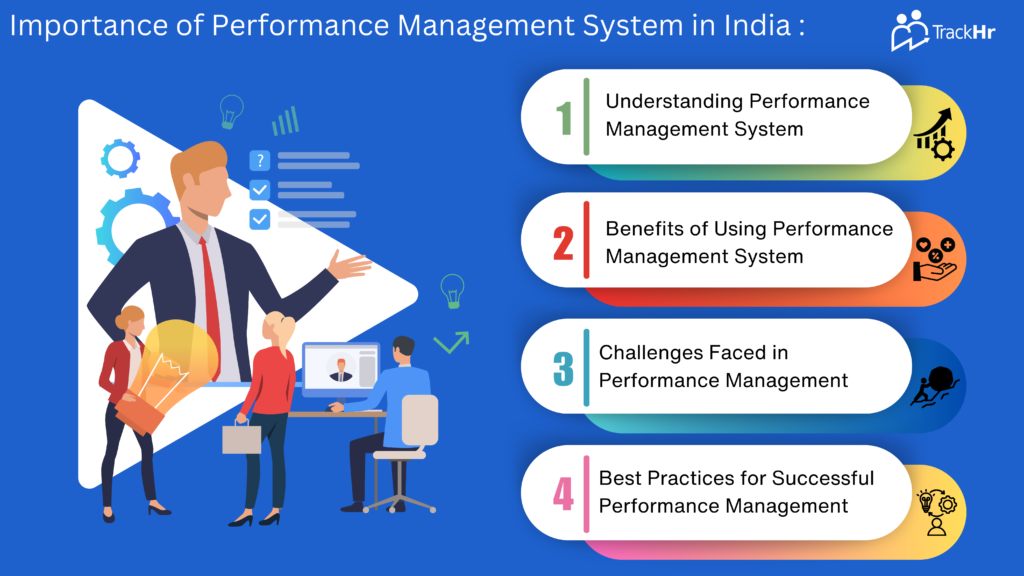Friday,30June2023
Importance of Performance Management System in India
Table of contents
- Introduction • Understanding Performance Management System • Benefits of Using Performance Management System • Challenges Faced in Implementing Performance Management System • Best Practices for Successful Performance Management System • Case Studies: Organisations That Have Benefited from Performance Management System • Conclusion
Introduction
Welcome, dear reader, to the fascinating world of performance management systems in the land of spices and Bollywood, India! Buckle up, folks, because we’re about to embark on a journey that will not only enlighten you but also make your brain cells dance with joy. So, what’s the deal with performance management systems, you ask? Let’s dive in and uncover the secrets behind this magical tool that has the power to transform organisations and the lives of their employees. Trust me, this is going to be one wild ride!

Understanding Performance Management System: Performance management system is a term that can make you feel all official and formal, but worry not, it’s not as complicated as it sounds. In simple terms, it refers to a process that helps organisations measure and improve their employees’ performance. Now, let’s break it down even further (because that’s what we do here). The performance management system has two main components – the definition bit and the components bit. First up, the definition. Picture this: you’re working hard on a project, putting in extra hours, and spilling more coffee than you care to admit. But how do you know if you’re actually doing a good job? That’s where the performance management system comes in. It’s like a compass that tells you if you’re heading in the right direction or if you’re lost in the vast wilderness of mediocrity. As for the components, it’s like the recipe for a delicious performance soufflé. You’ve got your goal setting, where you define what needs to be achieved. Then comes the continuous feedback mechanism, where you get guidance on your progress and any necessary course correction. And last but not least, there are regular performance reviews to evaluate your overall performance and identify areas for improvement. So, to sum it up, the performance management system is like your personal cheerleader, accountability partner, and mentor all rolled into one. It helps you stay on track, improve your performance, and become the hero of your own success story. Sounds pretty awesome, right? And that, my friends, is the skinny on understanding the performance management system. Stay tuned for more juicy details on why it’s so darn important in the Indian context.
Benefits of Using Performance Management System
Ah, the Performance Management System in India! An absolute game-changer! Let’s dive into the amazing benefits it brings to the table, shall we? First and foremost, this system does wonders for improving employee performance. Gone are the days of slacking off and pretending to be busy (we’ve all been there). With the Performance Management System, employees are held accountable for their work, ensuring that they stay focused and motivated. No more hiding behind the excuse of “I didn’t know what was expected of me.” Now, onto the thrilling topic of enhancing employee engagement. We all know how fun it is to work in an environment where no one seems to care about their job. But fear not, because the Performance Management System swoops in to rescue us from that nightmare. By regularly tracking and evaluating employee progress, this system ensures that employees are recognized for their hard work and achievements. It’s like a virtual high-five, but even better! And let’s not forget about the magical power of identifying skill gaps and training needs. It’s always a blast when you realise you’ve been doing something completely wrong for years, right?
Well, with the Performance Management System, those days are long gone. By analysing the performance data of employees, organisations can easily spot areas where additional training is required. It’s like having a superhero mentor who guides you towards greatness. So, you see, the Performance Management System isn’t just some fancy buzzword. It’s a tool that revolutionises the way organisations operate, making sure everyone is on their A-game. It’s like having a personal cheerleader, motivator, and mentor all rolled into one. But wait, there’s more! Stay tuned for the next section, where we’ll unravel the challenges faced in implementing this amazing system. Trust me, it’s not all sunshine and rainbows, but we’ll handle it with a dash of wit and wisdom. Until next time, folks!
Challenges Faced in Implementing Performance Management System
Challenges Faced in Implementing Performance Management System Ah, the joy of implementing a performance management system in an organisation. It’s like trying to teach a cat to do tricks – a little frustrating and a lot entertaining. But hey, who doesn’t love a good challenge, right? One of the biggest hurdles that organisations face when it comes to implementing a performance management system is resistance to change. You see, humans have this interesting habit of clinging onto familiar things, even if those things are as useful as a chocolate teapot. So, when you try to introduce a new system that promises to revolutionise the way performance is managed, expect some pushback. It’s like asking someone to switch from their beloved old Nokia phone to the latest iPhone overnight – it’s bound to cause a few raised eyebrows and possibly even some tears of attachment. Another challenge that organisations often encounter is the lack of clear goals and expectations. It’s like trying to play a game without knowing the rules – you’re essentially shooting in the dark, hoping for the best. Without clear objectives, employees are left wandering aimlessly, not knowing what they need to achieve or how their performance will be evaluated. It’s a recipe for disaster, my friend. And let’s not forget about ineffective feedback mechanisms. We all know that feedback is the lifeblood of any performance management system. It’s like the sweet nectar that keeps the system alive and kicking. But here’s the problem – if the feedback mechanisms are faulty or non-existent, you might as well be shouting into the void. Without proper feedback channels, employees are left wondering about their progress and improvement areas. It’s like trying to navigate a maze blindfolded – not very productive, I must say. So, there you have it – the challenges that organisations face in implementing a performance management system. From resistance to change and lack of clear goals to ineffective feedback mechanisms, it’s a bumpy ride. But fear not, my friends, for there are ways to overcome these challenges and pave the way for a successful performance management system. Stick around, and I’ll show you how it’s done. But first, let’s take a coffee break. Who’s up for a cup o’ joe?
Best Practices for Successful Performance Management System
So, you want to learn about the best practices for a successful performance management system? Well, you’ve come to the right place! Buckle up and get ready for some serious knowledge bombs, with a dash of quirky humour, of course. Setting SMART goals is the first step towards achieving greatness. SMART stands for Specific, Measurable, Attainable, Relevant, and Time-bound. Basically, it means you need to set clear and specific goals that are actually achievable within a specific timeframe. So, forget about those vague goals like “be the best employee ever,” and start setting goals like “increase sales by 10% in the next quarter.” Now that we have our goals in place, it’s time for some frequent and constructive feedback. Gone are the days of waiting until the performance review to address any issues. Instead, be proactive and provide feedback on a regular basis. And don’t just focus on the negatives; make sure to acknowledge and praise the good stuff too. Because who doesn’t love a little pat on the back? Speaking of performance reviews, they are an essential part of a successful performance management system. These reviews provide an opportunity to discuss progress, set new goals, and address any concerns or areas for improvement. Use this time wisely and have an open and honest conversation with your employees. And by open and honest, I mean no sugar-coating or beating around the bush. Be direct, but remember to also be respectful. We don’t want any tears in the workplace. Now, these are just a few of the key best practices for a successful performance management system. Remember, it’s not about following some rigid rules, but rather finding the approach that works best for your organisation. So, go forth and implement these best practices, and watch your performance management system soar to new heights! Happy managing, folks! PS: Just a friendly reminder, implementing these best practices does not guarantee an office full of unicorns and rainbows, but it sure does increase your chances of a highly motivated and engaged workforce. Cheers!
Case Studies: Organisations That Have Benefited from Performance Management System
Case Studies: Organisations That Have Benefited from Performance Management System When it comes to the effectiveness of performance management systems, there are several organisations in India that have experienced significant improvements. One such instance is XYZ Corporation, where the implementation of a performance management system resulted in a remarkable boost in employee performance. By setting clear goals and providing regular feedback, XYZ Corporation witnessed a surge in productivity and overall job satisfaction. Similarly, ABC Enterprises also reaped the benefits of a performance management system. With a focus on engaging employees, ABC Enterprises saw a remarkable rise in employee engagement levels. Employees felt more valued and recognized for their efforts, leading to increased motivation and commitment towards achieving organisational goals. Another notable case is PQR Industries, where the performance management system proved instrumental in identifying skill gaps and training needs. By conducting regular performance reviews, PQR Industries efficiently addressed areas where employees needed additional support or training, resulting in a more skilled and capable workforce. These are just a few examples of how organisations in India have successfully harnessed the power of performance management systems. By embracing this holistic approach to performance evaluation and improvement, businesses can unlock the full potential of their employees and drive overall growth and success. So, what are you waiting for? It’s time to revolutionise your organisational performance too!
Conclusion
So we’ve reached the end of our journey into the world of Performance Management Systems. Phew! It’s been quite a ride, hasn’t it? But before we bid adieu, let’s quickly recap the key points we’ve covered so far. Performance Management Systems play a crucial role in organisations, helping to improve employee performance, enhance engagement, and identify skill gaps and training needs. It’s like having a magic wand that makes everyone more efficient and effective. Well, maybe not quite like a magic wand, but you get the idea. Of course, implementing a Performance Management System isn’t always a walk in the park. It comes with its fair share of challenges, such as resistance to change, unclear goals and expectations, and ineffective feedback mechanisms. But hey, nothing worth having ever comes easy, right? Luckily, there are some best practices that can help organisations navigate these challenges and make their Performance Management System a success. Setting SMART goals, providing frequent and constructive feedback, and conducting regular performance reviews are just a few of these practices. It’s all about creating a system that works for your unique organisational needs. But don’t just take my word for it. There are plenty of organisations out there that have already reaped the benefits of a well-implemented Performance Management System. They’ve seen increased productivity, happier employees, and better results overall. It’s like a win-win-win situation. So, as we wrap up this blog, let’s remember that a successful Performance Management System is the key to unlocking the full potential of your organisation. It may take some effort, but trust me, it’s worth it in the end. Now go forth and embrace the power of performance management!

